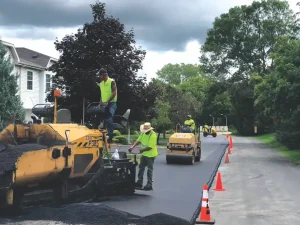Asphalt is the most popular paving option due to its fast installation and durability. It is also America’s most recycled material with tremendous environmental benefits. So, besides its functional properties, asphalt can help you reduce your environmental footprint. Asphalt recycling is increasingly becoming more widespread mostly because of its eco-friendly benefits in the current times when sustainability has become a top priority. Also, recycled asphalt is immensely cost-effective.
But how does the asphalt recycling process work, and what does it involve? Read on to learn more about the process and dynamics of asphalt recycling.
Asphalt Recycling Process
What is Asphalt?
Before diving into how the recycling process works, it is crucial first to understand what asphalt is made of. Asphalt is a mixture of aggregates, binders, and fillers. The common aggregates are sand, gravel, and crushed rocks. The binder that keeps the aggregate together is bitumen, a sticky, black, and highly viscous liquid. Bitumen is a natural byproduct of crude oil, and making asphalt prevents the substance from being wasted.
How the Process Works
Usually, asphalt removed from an old pavement (road, parking lot, driveway, etc.) is crushed and filtered at recycling plants. The milling process is used to crush the asphalt aggregates to desired sizes and texture for reclaimed asphalt. During recycling, aggregates are separated from binders, with each element recycled separately and later remixed to form recycled asphalt. In some cases, new materials may be added when remixing the elements.
There are multiple methods for recycling asphalt, the most common being hot or cold recycling and full-depth recycling (FDR). Described above is revamping old pavements for rebuilding and reusing. Below are the specific steps that take place inside the recycling plant:
- Asphalt millings or chunks are mixed in an asphalt recycler, where water and other additives may be added.
- For hot recycling, the mixture is tumbled and heated for about 20 minutes before it is ready. On the other hand, heat is not used for cold recycling, essential for saving energy.
- If the asphalt cement that glues the pavement together retains its adhesive properties, it can still be reused as a binding agent.
- The fine minerals generated naturally during recycling can also be reused, which helps conserve natural resources.
As described above, the asphalt recycling process is fast, easy, and environmentally friendly. It is eco-friendly, preventing toxic substances from ending up in landfills. Additionally, asphalt recycling can save you time and money.
Bottom Line
In the pursuit of sustainable solutions in building roads, driveways, sidewalks, walkways, and parking lots, asphalt emerges as the most preferred option. Recycling and the use of recycled asphalt is a brave move towards sustainable paving. Even better, with experienced paving service companies like Pro-Pave, it is possible to recycle asphalt with better quality and durability than the original material. For more information on asphalt recycling, contact us today for a free consultation.



